
In optics, aberration is a property of optical systems, such as lenses, that causes light to be spread out over some region of space rather than focused to a point. Aberrations cause the image formed by a lens to be blurred or distorted, with the nature of the distortion depending on the type of aberration. Aberration can be defined as a departure of the performance of an optical system from the predictions of paraxial optics. In an imaging system, it occurs when light from one point of an object does not converge into a single point after transmission through the system. Aberrations occur because the simple paraxial theory is not a completely accurate model of the effect of an optical system on light, rather than due to flaws in the optical elements.
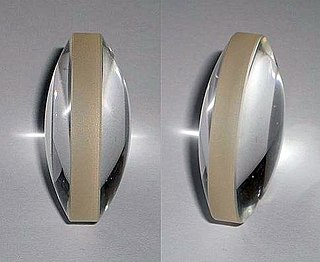
A lens is a transmissive optical device that focuses or disperses a light beam by means of refraction. A simple lens consists of a single piece of transparent material, while a compound lens consists of several simple lenses (elements), usually arranged along a common axis. Lenses are made from materials such as glass or plastic and are ground, polished, or molded to the required shape. A lens can focus light to form an image, unlike a prism, which refracts light without focusing. Devices that similarly focus or disperse waves and radiation other than visible light are also called "lenses", such as microwave lenses, electron lenses, acoustic lenses, or explosive lenses.

An achromatic lens or achromat is a lens that is designed to limit the effects of chromatic and spherical aberration. Achromatic lenses are corrected to bring two wavelengths into focus on the same plane. Wavelengths in between these two then have better focus error than could be obtained with a simple lens.
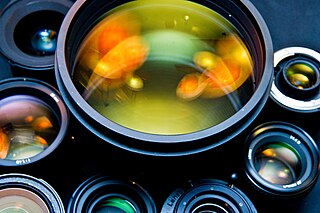
A camera lens is an optical lens or assembly of lenses used in conjunction with a camera body and mechanism to make images of objects either on photographic film or on other media capable of storing an image chemically or electronically.

A telephoto lens, in photography and cinematography, is a specific type of a long-focus lens in which the physical length of the lens is shorter than the focal length. This is achieved by incorporating a special lens group known as a telephoto group that extends the light path to create a long-focus lens in a much shorter overall design. The angle of view and other effects of long-focus lenses are the same for telephoto lenses of the same specified focal length. Long-focal-length lenses are often informally referred to as telephoto lenses, although this is technically incorrect: a telephoto lens specifically incorporates the telephoto group.

The Angénieux retrofocus photographic lens is a wide-angle lens design that uses an inverted telephoto configuration. The popularity of this lens design made the name retrofocus synonymous with this type of lens. The Angénieux retrofocus for still cameras was introduced in France in 1950 by Pierre Angénieux.
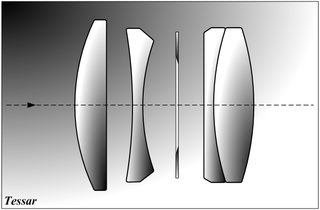
The Tessar is a photographic lens design conceived by the German physicist Paul Rudolph in 1902 while he worked at the Zeiss optical company and patented by Zeiss in Germany; the lens type is usually known as the Zeiss Tessar.

An apochromat, or apochromatic lens (apo), is a photographic or other lens that has better correction of chromatic and spherical aberration than the much more common achromat lenses.

A catadioptric optical system is one where refraction and reflection are combined in an optical system, usually via lenses (dioptrics) and curved mirrors (catoptrics). Catadioptric combinations are used in focusing systems such as searchlights, headlamps, early lighthouse focusing systems, optical telescopes, microscopes, and telephoto lenses. Other optical systems that use lenses and mirrors are also referred to as "catadioptric", such as surveillance catadioptric sensors.
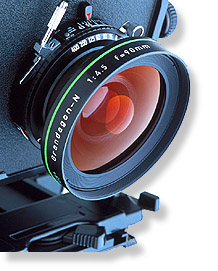
Large format lenses are photographic optics that provide an image circle large enough to cover the large format film or plates used in large format cameras.
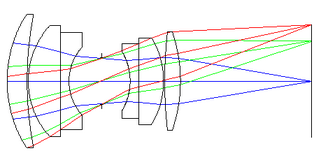
The double Gauss lens is a compound lens used mostly in camera lenses that reduces optical aberrations over a large focal plane.
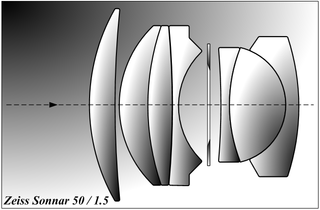
The Zeiss Sonnar is a photographic lens originally designed by Dr. Ludwig Bertele in 1929 and patented by Zeiss Ikon. It was notable for its relatively light weight, simple design and fast aperture.

An anastigmat or anastigmatic lens is a photographic lens completely corrected for the three main optical aberrations: spherical aberration, coma, and astigmatism. Early lenses often included the word Anastigmat in their name to advertise this new feature.

The Gauss lens is a compound achromatic lens that uses two uncemented elements; in its most basic form, a positive meniscus lens on the object side and a negative meniscus lens on the image side. It was first proposed in 1817 by the mathematician Carl Friedrich Gauss for a refracting telescope design, but was seldom implemented and is better known as the basis for the Double-Gauss lens first proposed in 1888 by Alvan Graham Clark, which is a four-element, four-group compound lens that uses a symmetric pair of Gauss lenses.
The design of photographic lenses for use in still or cine cameras is intended to produce a lens that yields the most acceptable rendition of the subject being photographed within a range of constraints that include cost, weight and materials. For many other optical devices such as telescopes, microscopes and theodolites where the visual image is observed but often not recorded the design can often be significantly simpler than is the case in a camera where every image is captured on film or image sensor and can be subject to detailed scrutiny at a later stage. Photographic lenses also include those used in enlargers and projectors.

Biogon is the brand name of Carl Zeiss for a series of photographic camera lenses, first introduced in 1934. Biogons are typically wide-angle lenses.

Topogon is a wide field, symmetrical photographic lens patented by Robert Richter in 1933 for Carl Zeiss AG. As there are four meniscus elements in four groups, deployed symmetrically around the central aperture, it is considered a double Gauss lens variant.

The invention of the camera in the early 19th century led to an array of lens designs intended for photography. The problems of photographic lens design, creating a lens for a task that would cover a large, flat image plane, were well known even before the invention of photography due to the development of lenses to work with the focal plane of the camera obscura.

Rodenstock Photo Optics traces its origins to a mechanical workshop founded in 1877 by Josef Rodenstock and his brother Michael in Würzburg, Germany. The company relocated to Munich by 1884 and became an important manufacturer of both corrective lenses for glasses and camera lenses by the early 1900s. These two lines began to diverge in the 1960s as the center of photographic lens manufacturing shifted to Japan; the ophthalmic business continued as Rodenstock GmbH while the remaining camera lens business was repositioned to serve the large format and industrial precision optics markets, then spun off in 1996 as Rodenstock Präzisionsoptik. Since then, the precision optics brand has been acquired in succession by LINOS Photonics, Qioptiq Group, and Excelitas Technologies (2013).
















